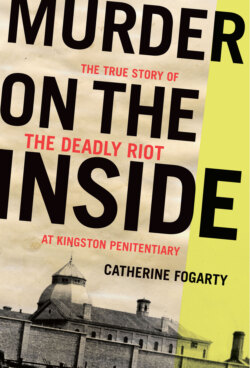Читать книгу Murder on the Inside - Catherine Fogarty - Страница 11
На сайте Литреса книга снята с продажи.
5 The Embers of Discontent
ОглавлениеOn the afternoon of Friday, August 13, 1954, a group of Kingston Penitentiary prisoners attacked a prison guard in the exercise yard. Local papers reported that officer Robert Wylie had been hit by a baseball bat while the inmates were playing a morning baseball game. He managed to escape, but the prisoners then began setting fires in the prison with their cigarette lighters. Inmates were not allowed to carry matches. Shouting, “Burn the hellhole to the ground,” small gangs of rioters ran through the east and north wings and then towards other buildings south of the main cellblock.57
The fire destroyed the iconic cupola of the main dome that had been part of the Kingston skyline for more than a hundred years.58 The fire was eventually contained, but two days later inmates set more fires, destroying many of the shops and the historic horse stable. Fortunately inmates were able to save the eight horses inside the stable.
The Whig-Standard reported that more than 160 armed soldiers were keeping guard against a possible prison breakout. The Kingston Police chief at the time, T.J. Truaisch, said that the entire city police force had been called to the prison, while the Royal Canadian Mounted Police patrolled the harbour.
Once the fires were controlled and the prisoners were returned to their cells, guards found an assortment of baseball bats, chisels and knives littering the exercise yard. A hundred-foot rope with a large steel hook on the end was also discovered. Inmates interviewed after the riot confirmed that the fires were set as a diversion for a mass escape attempt, but not a single inmate had even tried to get over one of the thirty-foot walls of the prison.
The riot lasted ten hours and caused over $2 million in damage to the prison. The inmates were quickly put to work repairing the extensive destruction of the main cellblock and shops. In a 1954 Maclean’s article about the riot, a former prisoner who was released the following day described the event as a senseless act initiated by a small, aimless gang of convicts determined to destroy all they could. But having spent six years in KP, he understood why riots happen. “A prison is an active volcano, churning and bubbling under the pressure of monotony and routine ,” wrote ex-con #1604. “I think prisoners riot because they can’t help it. It is natural reaction to an unnatural existence.”
The uprising at Kingston Pen coincided with another federal investigation into the correctional system. The Fauteux Committee established a year before, in 1953, determined that prisons could not just fulfill a custodial role, but needed to begin addressing the behaviour and attitudes of inmates. Prisons needed to adopt programs designed to tackle the root causes of crime while also providing vocational training, pre-release programs and aftercare support. The report redefined the goals of corrections as the reform and rehabilitation of offenders, rather than merely their custody. The Fauteux Report recommended hiring better-trained personnel with professional qualifications in criminology, psychiatry, psychology, social work and law.
The report also examined the field of remission and parole. A key recommendation was to create a national board of parole that would extend to all federal offenders and replace the archaic Ticket of Leave System (TLA) that had been in place since 1899. Under the Ticket of Leave, offenders could be granted early leave from a penitentiary at the discretion of the Governor General, but wardens in each institution also had the power to make arbitrary parole decisions. A new parole act was passed in 1959, creating the National Parole Board, the first independent decision-making tribunal in Canada.
After the 1954 riot, Kingston Pen did not experience any more fires, but the embers of discontent continued to smoulder for seventeen years, until Billy Knight and a small group of disgruntled inmates reignited the sparks of rebellion.
